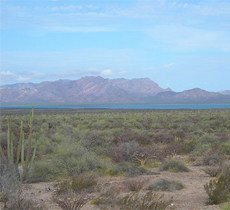The government of Mexico has designated its 114th Wetland of International Importance for the Ramsar List.“Canal del Infiernillo y esteros del territorio Comcaac (Xepe Coosot)” (29,700 hectares, 29°10’N 112°14’W) is a channel between Island Tiburón and the Sonora coast in northwestern Mexico, characterized by the presence of sea-grass beds, mangrove estuaries, seasonal creeks and small coral reef patches.
According to Ramsar’s Assistant Advisor for the Americas, Nadia Castro, based upon the accompanying data sheets, the sea-grass beds are the largest concentration of annual marine grasses in the eastern Pacific, and the mangroves are located at the northern limit of this vegetation type. These wetlands provide refuge, substrate and food to several species that are the basis for commercial and artisanal fisheries. In addition, the site is habitat of 81 endemic invertebrate species of Gulf of California and several threatened species, such as mangroves (Avicennia germinans, Laguncularia racemosa and Rhizophora mangle), totoaba (Totoaba macdonaldi), marine turtles (Eretmochelys imbricata, Caretta caretta, Dermochelys coriaceai, Lepidochelys olivacea and Chelonia mydas agassizi) and Brant Goose (Branta bernicla). For more than 2000 years the ethnic group Comcaac has inhabited this region and show an extensive ecological traditional knowledge, upon which they base their fisheries management practices.
In contrast to several other regions in the Gulf, the seabeds in the site have not been disturbed by the nets of shrimp vessels, but they are currently threatened by overfishing and tourist development.
Mexico presently has 114 Ramsar sites covering 8,191,057 hectares – the Convention’s global total is 1873 Ramsar sites covering 184,030,126 hectares. 


 English
English  Español
Español